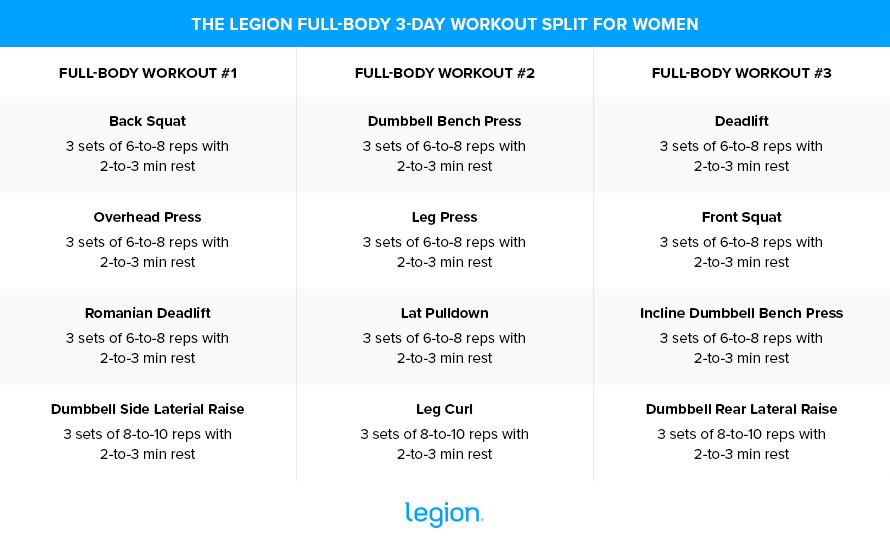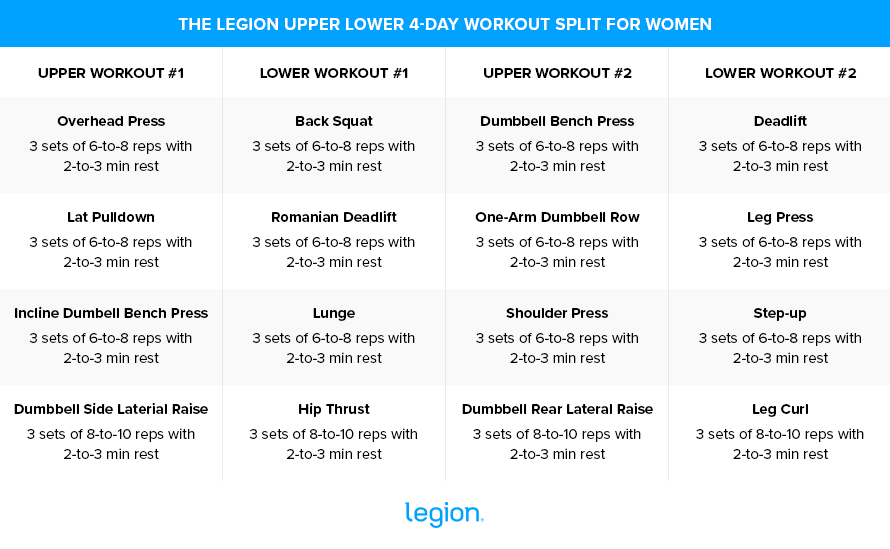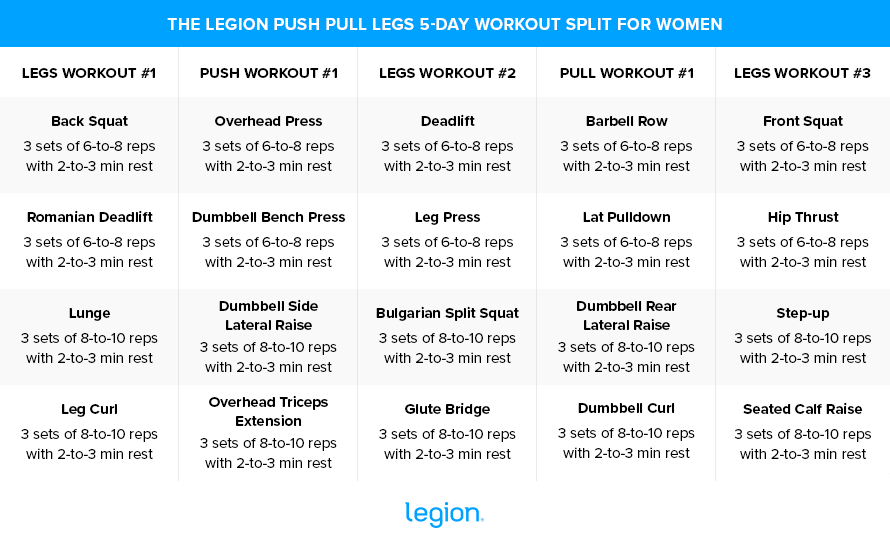Here’s a truth few fitness folk realize: women’s workout splits should be more or less identical to men’s workout splits.
The reason?
The principles that drive muscle growth are the same for both men and women.
(There are a few minor exceptions, which you’ll learn about in this article).
Why, then, are female workout splits often quite different from male workout splits?
Mainly because of preferences—most women want a bigger butt and more defined legs, whereas most men want a more muscular upper body.
Thus, the best workout split for women boils down to training the same way guys do while focusing on a different set of muscles.
In this article, you’ll learn how to choose the best workout split for your goals, the three best workout splits women can do, and more.
Table of Contents
+
Benefits of Following a Workout Split
Following a female workout split has a few major advantages over randomly selecting exercises on the days you train:
- It ensures your workouts are focused and purposeful because you have a set plan.
- It allows you to track progress more easily because you do the same exercises in the same order each week.
- It guarantees you train all your major muscle groups so you don’t develop muscle imbalances.
- It ensures you get adequate rest.
- Because of the above, it increases your odds of making progress (losing weight, building muscle mass, etc.), which further boosts motivation.
How to Choose the Best Women’s Workout Split for You
While many workout splits for women exist, only a handful are worth following.
To ensure you choose the right female workout split for you, ask yourself the following questions:
- What can I consistently do every week?: It’s better to consistently stick to a minimalist workout split than occasionally stick to a more rigorous one.
- What suits my experience level?: Beginners can make excellent progress doing just 3 or 4 workouts weekly. More experienced weightlifters will progress faster by training more often.
- What muscle groups do you most want to develop?: Different workout splits prioritize different muscle groups. Follow one that emphasizes the body parts you want to develop most.
Women’s 3-Day Workout Split: Full Body
While full-body workout splits have been around forever, they’ve experienced a resurgence in recent years, particularly among women.
Part of the reason is that research suggests women recover faster from their workouts than men, so they should benefit from training each body part more frequently than once or twice weekly. And full-body workout splits are as “high frequency” as strength training workout plans come.
The idea behind full-body 3-day workout splits is simple: train every major muscle group in the body in each of your three weekly workouts.
Here’s how this might look:

The primary benefits of a 3-day workout split for women are:
- You don’t often feel sore because you never train any single muscle group with “high volume” (lots of sets) in one workout.
- It’s flexible. If you miss a day, it doesn’t mess up your whole week, unlike other plans where missing a session can complicate your schedule.
- It may help you build muscle by keeping muscle protein synthesis rates elevated more than other splits.
The only significant drawbacks are that full-body workouts tend to be slightly longer than other workouts, and because you train each major muscle group several times weekly on a full-body split, you risk “overtraining” if you don’t manage your volume and exercises properly.
To avoid running yourself ragged on a full-body 3-day workout split, it’s vital to follow a well-designed program like this:

Women’s 4-day Workout Split: Upper Lower
The 4-day upper lower workout split divides your weekly workouts into upper- and lower-body workouts. Typically, you do 2 upper-body workouts and 2 lower-body workouts per week for a total of 4 weight training days a week.
On “upper days,” you train all the muscles in your upper body, including your chest, back, shoulders, and arms, and on “lower days,” you train all the muscles in your lower body, including your quads, hamstrings, glutes, and calves.
Here’s how you might schedule your workouts on an upper lower 4-day workout split:

The upper lower split is a popular women’s workout split because it’s simple, time-efficient, includes an effective mix of volume and frequency, and allows plenty of time for recovery. It also devotes more time to lower-body training than most other workout splits.
While there aren’t any inherent problems with the upper lower split, workouts can drag if you organize it poorly. For instance, trying to train your chest, back, shoulders, biceps, triceps, and core in the same session can take a long time.
You can easily fix this problem, of course. A simple solution is to train your chest and back on one upper-body day and your remaining upper-body muscles on your second weekly upper-body workout.
You also don’t need to spend the same time training your upper body as your lower body. If you’re more concerned with getting shapely legs and a gravity-defying butt than you are with building your upper body, it makes sense to make your lower body workouts longer and your upper body workouts shorter.
The upper lower 4-day workout split is ideal for women who want to develop their entire body but pay particular attention to their legs and butt:

Women’s 5-Day Workout Split: Push Pull Legs
The idea of the push pull legs split is simple:
- Push days train all the muscles that push things away from your torso, like your chest, shoulders, and triceps.
- Pull days train all the muscles involved in pulling things off the floor or toward your torso, like your back and biceps.
- Leg days train all the lower-body muscles.
Push pull legs workout routines work well because muscles generally operate in pairs.
For instance, your chest, shoulders, and triceps work during a pushing exercise like the bench press, while your back and biceps take a back seat. Conversely, your back and biceps do most of the work in a barbell row, allowing your pushing muscles to rest.
By rotating between push, pull, and leg workouts, you can effectively train different body parts while others recover. This way, you’re likely to start each workout feeling fresh.
There are countless ways to organize a push pull legs routine, but for women who want to emphasize their lower body, the following schedule works best:

A major benefit of a push pull legs 5-day split workout is it allows you to train your lower body with plenty of volume, which is generally beneficial for growth. It also gives you enough time to work on your upper body, helping to prevent imbalances between your upper and lower halves.
However, a push pull legs 5-day workout split isn’t for everyone, primarily because it demands a lot of time for training and that you prioritize recovery. If you don’t meet these prerequisites, a different female workout split is likely more suitable.
Moreover, training five days per week is overkill for most. Unless you’re an experienced weightlifter (more than three years of consistent training experience) who has plateaued on an easier routine, a less demanding workout plan might be a better fit.
Here’s an example push pull legs 5-day workout split for women that’s ideal for experienced weightlifters looking to ring out the last of their genetic potential for muscle and strength gain:

FAQ #1: What’s a good gym schedule for women?
A good gym schedule for women balances workout frequency with recovery time. Beginners can see excellent progress with 3 or 4 weekly workouts, while more experienced weightlifters might need to train 4-to-5 days per week.
Disregard anyone who says you need to train more than this. While 6- and 7-day workout splits for women exist, they’re almost always too demanding. For the vast majority of ladies, dedicating at least two days a week to rest is optimal (taking Saturday and Sunday rest days works well for most).
FAQ #2: What’s the best workout split for fat loss?
While strength training can help boost fat loss, it doesn’t drive it as well as a calorie-controlled diet. For specific advice about how many calories, how much of each macronutrient, and which foods you should eat to reach your health and fitness goals, take the Legion Diet Quiz, and in less than a minute, you’ll know exactly what diet is right for you. Click here to check it out.)
FAQ #3: What is the most effective workout split for beginners?
A 3- or 4-day workout split works best for most beginners because it provides enough stimulus to spur progress while allowing plenty of recovery time.
+ Scientific References
- Hagstrom, Amanda D, et al. “The Effect of Resistance Training in Women on Dynamic Strength and Muscular Hypertrophy: A Systematic Review with Meta-Analysis.” Sports Medicine (Auckland, N.Z.), 2019, pp. 10.1007/s40279-01901247-x, www.ncbi.nlm.nih.gov/pubmed/31820374, https://doi.org/10.1007/s40279-019-01247-x. Accessed 12 Dec. 2019.
- Judge, Lawrence W., and Jeanmarie R. Burke. “The Effect of Recovery Time on Strength Performance Following a High-Intensity Bench Press Workout in Males and Females.” International Journal of Sports Physiology and Performance, vol. 5, no. 2, June 2010, pp. 184–196, https://doi.org/10.1123/ijspp.5.2.184.
- Damas, Felipe, et al. “A Review of Resistance Training-Induced Changes in Skeletal Muscle Protein Synthesis and Their Contribution to Hypertrophy.” Sports Medicine, vol. 45, no. 6, 6 Mar. 2015, pp. 801–807, https://doi.org/10.1007/s40279-015-0320-0.
- Zaroni, Rafael S., et al. “High Resistance-Training Frequency Enhances Muscle Thickness in Resistance-Trained Men.” Journal of Strength and Conditioning Research, vol. 33, July 2019, pp. S140–S151, https://doi.org/10.1519/jsc.0000000000002643. Accessed 29 July 2019.
- Schoenfeld, Brad J., et al. “Influence of Resistance Training Frequency on Muscular Adaptations in Well-Trained Men.” Journal of Strength and Conditioning Research, vol. 29, no. 7, July 2015, pp. 1821–1829, journals.lww.com/nsca-jscr/Pages/ArticleViewer.aspx?year=2015&issue=07000&article=00008&type=Fulltext, https://doi.org/10.1519/jsc.0000000000000970. Accessed 17 Apr. 2019.












